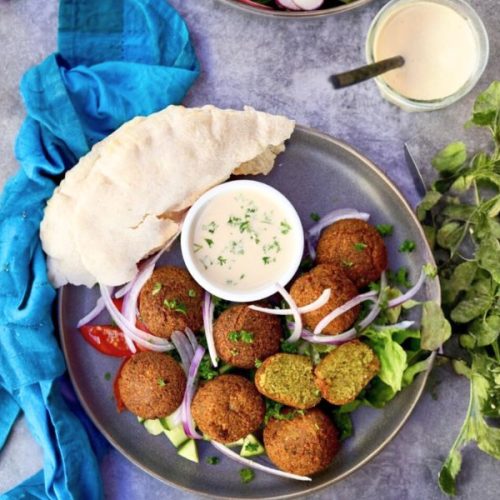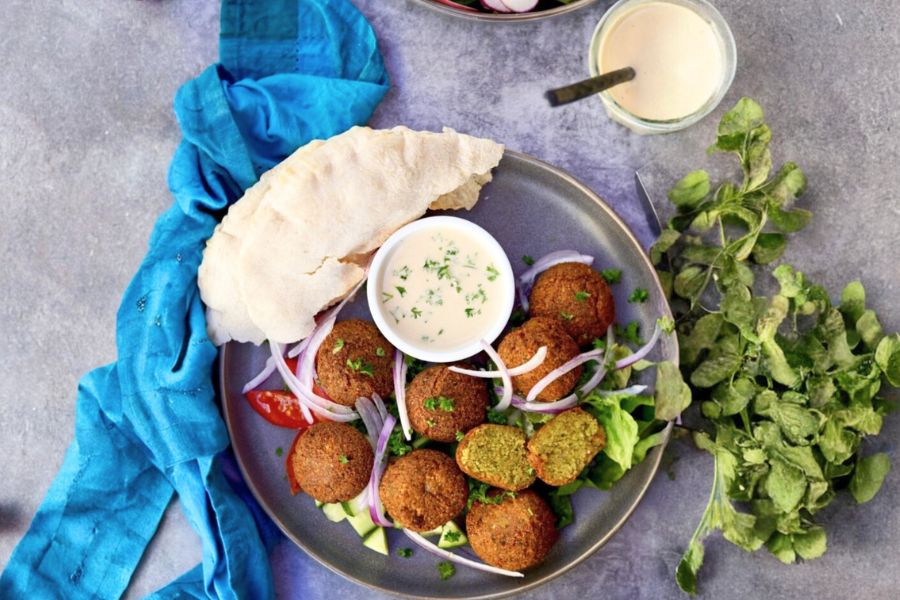This falafel with tahini sauce recipe brings the bold, comforting flavors of the Middle East straight into your kitchen, offering a deeply satisfying, plant-based alternative to meat-heavy meals.
What sets it apart is the use of dried chickpeas soaked overnight, giving the falafel a superior texture — crisp on the outside, tender and herby inside.
It’s a high-protein, fiber-rich dish that supports digestive health and keeps you full for hours.
Naturally low in saturated fat and entirely plant-based, it’s perfect for anyone following vegetarian, vegan, or heart-healthy diets.
The inclusion of fresh herbs, garlic, and warming spices adds not just flavor but a nutritional boost from antioxidants.
The tahini sauce adds healthy fats from sesame seeds, making this dish well-balanced and delicious.

Whether served in a pita, over a salad, or as part of a meal prep bowl, this falafel is a versatile, satisfying option for everyday cooking — budget-friendly, freezer-friendly, and easy enough for weeknights.
Must-Have Tools for Perfect Results
Cuisinart 14-Cup Food Processor
Essential for pulsing soaked chickpeas into the perfect falafel texture. This processor offers consistent chopping and blending power, making it a time-saving hero for sauces, dips, dough, and more.
Lodge 6-Quart Enameled Cast Iron Dutch Oven
Perfect for deep frying your falafel thanks to its excellent heat retention and even cooking. Beyond falafel, it’s ideal for stews, soups, and baking artisan bread.
OXO Good Grips Medium Cookie Scoop
This scoop makes portioning falafel balls effortless and uniform, ensuring even cooking. It’s a multipurpose tool great for cookie dough, meatballs, and more.
ThermoPro Digital Instant Read Thermometer
Ensures your oil reaches the ideal 360–375°F for crisp falafel. Also useful for perfectly cooked meats, candy making, or baking.
Breville Fresh & Furious Blender
Ideal for blending the smooth, creamy tahini sauce. Its high-speed blending action is perfect for dressings, smoothies, and sauces.

Crispy Falafel with Tahini Sauce
Equipment
- 1 Food Processor
- 1 Blender or Food Processor (for tahini sauce)
- 1 Medium Stock Pot or Dutch Oven
- 1 Slotted Spoon
- 1 Digital Thermometer
- 1 Mixing Bowl
- 1 Rubber spatula
- Paper Towels (for draining)
- Plastic Wrap (for refrigerating mixture)
Ingredients
For the Falafel:
- 1 lb dried chickpeas approximately 2 cups
- ½ cup roughly chopped yellow onion
- ¼ cup chopped fresh parsley
- 4 garlic cloves
- 1½ tablespoons all-purpose flour
- 1¾ teaspoons sea salt
- 2 teaspoons ground cumin
- 1 teaspoon ground coriander
- ¼ teaspoon ground black pepper
- ⅛ to ¼ teaspoon cayenne pepper adjust for heat
- Pinch of ground cardamom
- 2 teaspoons baking soda mixed with 1 tablespoon water
- Vegetable oil for frying
For the Creamy Tahini Sauce:
- 1 cup tahini sesame seed paste
- ¾ cup lukewarm water plus more if needed for consistency
- 3 garlic cloves
- ¼ cup fresh lemon juice or to taste
- ¼ teaspoon sea salt or more to taste
Instructions
- oak the Chickpeas Overnight: Place the dried chickpeas in a large bowl and cover them with cold water, leaving at least 3 inches of water above the beans. Let them soak at room temperature for 12–18 hours. They will double in size, becoming tender but not cooked.
- Prepare the Falafel Mixture: After soaking, drain and rinse the chickpeas thoroughly. Transfer them to a food processor along with the chopped onion, parsley, garlic cloves, flour, salt, cumin, coriander, black pepper, cayenne, and cardamom. Pulse the mixture until it forms a coarse, grainy texture — similar to couscous. Avoid overprocessing into a paste. Scrape down the sides of the bowl as needed.
- Incorporate Leavening: Stir together the baking soda and water, then use a spatula to fold it into the falafel mixture until evenly combined. Cover the bowl with plastic wrap and refrigerate for at least 1 hour. This resting period helps the mixture bind and develop flavor.
- Form the Falafel Balls: Using wet hands or a cookie scoop, shape the chilled mixture into small balls or patties, about 2 tablespoons each. If the mixture feels too crumbly, blend it slightly more or add 1–2 extra tablespoons of flour until the balls hold their shape.
- Heat the Oil for Frying: Fill a deep skillet or Dutch oven with vegetable oil to about 1½ inches deep. Heat the oil over medium heat until it reaches 360–375°F (use a thermometer for accuracy). Test with one falafel to check the temperature — it should take about 2–3 minutes per side to brown.
- Fry the Falafel: Working in batches of 5–6, gently drop the falafel into the hot oil. Fry until deeply golden and crisp, about 2–3 minutes per side. Use a slotted spoon to transfer them to a paper towel-lined plate to drain excess oil.
- Make the Tahini Sauce: In a blender or food processor, combine the tahini, warm water, garlic, lemon juice, and salt. Blend until smooth and creamy, scraping down the sides as needed. If the sauce is too thick, blend in more water a tablespoon at a time until your desired consistency is reached. Adjust seasoning to taste.
- Serve and Enjoy: Serve the falafel hot with a drizzle of tahini sauce, warm pita, fresh vegetables, or a side of hummus. They also pair beautifully with salads or grain bowls.
Notes
- Don’t use canned chickpeas: Canned chickpeas are too soft and will make the mixture fall apart. Dry, soaked beans are essential for texture and structure.
- Make ahead: The falafel mixture can be made 1–2 days ahead and kept in the fridge until ready to fry.
- Freeze for later: Shaped, uncooked falafel balls can be frozen on a tray, then transferred to a freezer bag. Fry from frozen — just add a minute or two to the cook time.
- Baking or air frying option: Although traditional frying gives the best texture, you can bake or air-fry the falafel at 375°F until golden brown, flipping halfway through (about 25–30 minutes).
- Custom spice levels: Adjust cayenne for more or less heat, or experiment with adding chopped cilantro or mint to the herb blend.
Chef’s Secrets for Crispy Falafel
The secret to perfect falafel lies in the texture of the mixture and the temperature of the oil.
Always start with dry chickpeas soaked overnight — this ensures the falafel stays crisp on the outside and tender inside.
Never use canned beans; they contain too much moisture and can cause the balls to fall apart.
When blending your mixture, aim for a texture similar to coarse sand or couscous.
If it’s too smooth, the falafel can become dense or greasy.
Always chill the mixture before frying to help the balls hold their shape. Adding a pinch of baking soda mixed with water gives the falafel a light, airy interior.
Finally, make sure your oil is between 360–375°F (182–190°C) — this is the sweet spot for deep-frying. Too cool, and your falafel will absorb oil and turn soggy; too hot, and they’ll burn before the inside cooks through.
Delicious Ways to Serve Falafel
Falafel is wonderfully versatile and pairs well with a variety of accompaniments.
For a classic presentation, serve the crispy balls inside warm pita bread with a drizzle of creamy tahini sauce, crunchy cucumbers, tomatoes, pickled onions, and fresh greens.
You can also create a falafel bowl by layering them over a bed of rice, quinoa, or couscous with chopped veggies, hummus, and a tangy lemon dressing.
For a lighter, low-carb option, falafel is delicious served on a large salad with roasted vegetables or wrapped in lettuce leaves. Entertaining?
Offer mini falafel as appetizers or party bites with tahini, tzatziki, or garlic yogurt dipping sauces.
Whether it’s lunch, dinner, or a snack, falafel adapts beautifully to your mood and meal plan.
Best Storage Tips and Tricks
Proper storage can make your falafel last longer while preserving its flavor and texture.
Cooked falafel can be stored in an airtight container in the fridge for up to 4 days.
To reheat, place them in a toaster oven or air fryer at 350°F (175°C) for 5–7 minutes to restore their crispness.
Avoid microwaving, as this can make them soft and soggy. If you want to meal prep ahead, shape the uncooked falafel balls and freeze them on a tray until solid. Then transfer to a freezer-safe bag or container.
These can be fried straight from frozen — just fry an extra minute or two.
You can also freeze the cooked falafel, although the texture is best when fried fresh. The tahini sauce can be kept in the fridge in a sealed jar for up to 1 week. If it thickens, just stir in a splash of warm water to loosen it up.
Top Questions About This Recipe
1. Can I use canned chickpeas instead of dried?
Canned chickpeas are too soft and moist for this recipe and will not produce the same crispy, structured falafel. For the best results, always use dried chickpeas soaked overnight. This helps maintain the traditional texture and keeps the falafel from falling apart.
2. What oil is best for frying?
Use a neutral, high-heat oil like vegetable oil, canola oil, grapeseed oil, or sunflower oil. Avoid olive oil, as it has a lower smoke point and can impart a bitter flavor when used for deep frying.
3. Can I bake or air-fry the falafel?
Yes! While frying gives the crispiest texture, you can bake falafel at 375°F (190°C) for 25–30 minutes, flipping halfway. Alternatively, air-fry at 375°F for 15–18 minutes for a healthier version with great crunch.
4. How can I make this gluten-free?
Swap out the all-purpose flour for chickpea flour or a gluten-free all-purpose flour blend. These alternatives help bind the mixture without affecting the flavor or crispiness.
5. Why is my falafel falling apart?
If your falafel won’t hold together, the mixture may be too dry or too coarse. Try pulsing the mix a bit more in the processor, or add an extra tablespoon of flour. Also, make sure the mixture is chilled before forming the balls — this helps them stick better during frying.
This recipe has been adapted and simplified from the original version by simmerandsauce. We’ve refined the steps for a smoother cooking experience and added helpful notes, nutrition insights, and essential kitchen tools to make it even easier for home cooks.

